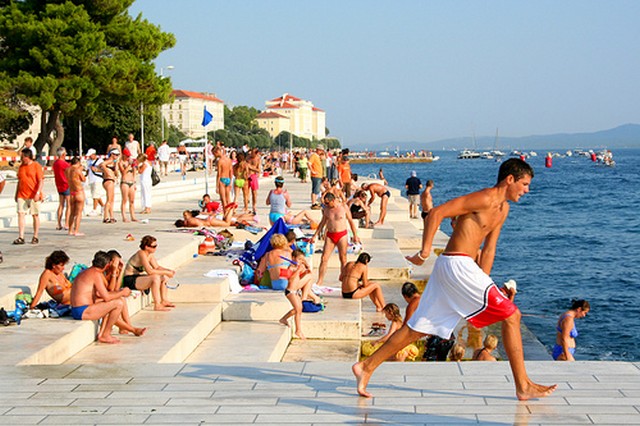Another gorgeous day in Croatia - a day of dramatic changes in scenery - lush forests and lakes to beautiful coastlines. Leaving Plitvice Lakes today and heading back to the Adriatic Coast and warmer weather - rather a cool night and morning up in the mountains. On our way to Zadar we stopped to look at 2 orphaned brown bears - larger than I had expected. They love eating oranges so we fed them - amazingly they peeled the orange to eat the pulp. They looked sooo friendly and lovable behind the fence.
The southern stretch of Croatia's Dalmatian coast is saturated with sunseekers at this time of year but Zadar in the north where we have spent the past 2 days is a region rich in history and natural beauty, which is still relatively undiscovered. We have wandered round quiet streets of marble, and walked and swum on pine-scented beaches. In the old town Roman ruins stand alongside Romanesque churches.
Two of Zadar’s most popular attractions are the Sea Organ and Sun Salutation – two artistic installations, which utilise the power of nature to create beautiful sounds and sights for the citizens and visitors of Zadar. In the Second World War most of Zadar’s sea front was destroyed – and then quickly repaired as a boring, monotonous concrete wall. In order to bring some life and something different to the sea front, architect Nikola Basic designed and opened the Sea Organ and Sun Salutation in 2005. The Sea Organ is an experimental musical instrument, which plays music generated by the motion of sea waves through a series of 35 organ pipes built under a set of large marble steps. As the movement and energy of the sea, in terms of tides and winds, is unpredictable then the sea organ produces a infinitely long, random, yet mournful sound. The “music” is created by pipes of different lengths and sizes with whistles built in them, which play seven chords of five tones as the waves force air through them. The pipes are built into seven steps, each one with its own tubing and chord, so as you move along the sea front the sounds and harmonies you hear change relative to your position.
After watching the sun set, you then head over towards the Sun Salutation, located a few hundred metres away from the Sea Organ. The Sun Salutation is a 22 metre diameter solar panel formed from 300 multi-layered glass panels. Underneath these glass conduction plates, there are a series of solar cells. The solar cells absorb the Sun’s energy from sunrise to sunset, and convert this energy into electricity. The electricity produced is then used to light the entire waterfront at night – a unique example of an efficient and renewable energy source. At sunset, the installation switches on and displays a series of bright colourful lights. The motion of the lights is dependent on the solar energy collected throughout the day as well as the power of the waves, and is supposed to also represent the motion of the solar system. All eight planets are represented by proportionally sized solar lights placed at their proportional distances from the sun.
We are going down to the waterfront to experience these tonight - have seen them during the day and the sea organ produces an eerie sound - should be a wonderful sight and sound at sunset. The lights on the solar panels are supposed to be amazing.
After watching the sun set, you then head over towards the Sun Salutation, located a few hundred metres away from the Sea Organ. The Sun Salutation is a 22 metre diameter solar panel formed from 300 multi-layered glass panels. Underneath these glass conduction plates, there are a series of solar cells. The solar cells absorb the Sun’s energy from sunrise to sunset, and convert this energy into electricity. The electricity produced is then used to light the entire waterfront at night – a unique example of an efficient and renewable energy source. At sunset, the installation switches on and displays a series of bright colourful lights. The motion of the lights is dependent on the solar energy collected throughout the day as well as the power of the waves, and is supposed to also represent the motion of the solar system. All eight planets are represented by proportionally sized solar lights placed at their proportional distances from the sun.
We are going down to the waterfront to experience these tonight - have seen them during the day and the sea organ produces an eerie sound - should be a wonderful sight and sound at sunset. The lights on the solar panels are supposed to be amazing.
 |
| No - they're not real |












No comments:
Post a Comment